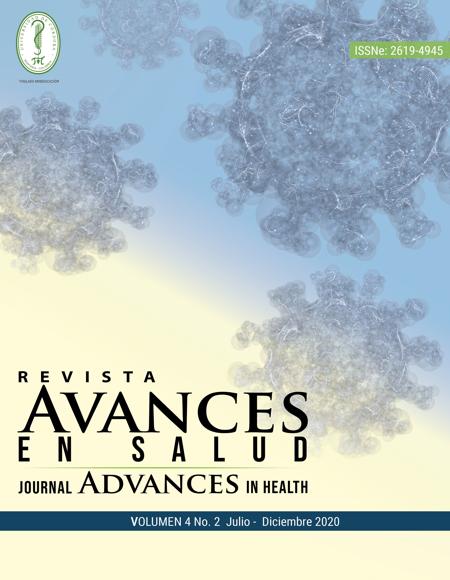Eficacia y seguridad del policresuleno en el aclaramiento del virus del papiloma humano (VPH)
Efficacy and safety of polyresullen in the clearance of human papillomavirus (HPV) Eficacia y seguridad del policresuleno en el aclaramiento del virus del papiloma humano (VPH)

Esta obra está bajo una licencia internacional Creative Commons Atribución-CompartirIgual 4.0.
Mostrar biografía de los autores
Objetivo: Evaluar la eficacia y seguridad del policresuleno como coadyuvante en el aclaramiento del virus del papiloma humano, en mujeres con lesión escamosa intraepitelial de bajo grado (LEI-BG). Material y métodos: ensayo clínico aleatorizado, controlado, triple ciego, en una población de 416 participantes, entre 2017 y 2019. Se incluyeron mujeres mayores de 30 años que no estaban en la menopausia, a las cuales se les diagnosticó lesión escamosa intraepitelial de bajo grado (LEI-BG) positivas para VPH, a través de colposcopía, biopsia y tamizaje. Un grupo («1»: n=207) recibió policresuleno, el grupo «2» (n=209) recibió placebo. Resultados: la edad media fue de 34,62 ± 10,89 años. El policresuleno fue efectivo para el control del VPH, lográndose una negativización del 89,85% frente al 64,59% del placebo (p<0,001) a los 12 meses. La incidencia de efectos secundarios fue la siguiente: sequedad vaginal (7,24%) y la descarga de fragmentos de membrana mucosa (8,69%) en el grupo policresuleno frente al 6,69% y 8,13%, respectivamente, del grupo placebo (p=0,051). Conclusiones: La mejoría del 89,85% de la LEI-BG positivas para VPH, en mujeres mayores de 30 años, significativa que el uso del policresuleno es una efectiva y segura opción terapéutica.
Visitas del artículo 9540 | Visitas PDF
Descargas
1) Zur Hausen H. Papillomaviruses causing cancer: Evasion from host-cell control in early events in carcinogenesis. J Natl Cancer Inst. 2000; 92(9):690-8. http://dx.doi.org/10.1093/jnci/92.9.690.
2) Stanley M, Lowy DR, Frazer I. Chapter 12: Prophylactic HPV vaccines: Underlying mechanisms. Vaccine. 2006; 116(5):1167-73. http://dx.doi.org/10.1172/JCI28607
3) Stanley MA. Genital human papillomavirus infections: Current and prospective therapies. J Gen Virol. 2012; 93:681-91 http://dx.doi.org/10.1099/vir.0.039677-0
4) Grillo-Ardila CF, Martínez-Velásquez MY, Morales-López B. Virus del papiloma humano: aspectos moleculares y cáncer de cérvix. Rev Colomb Obstet Ginecol. 2008; 59(4):310-15.
5) Ho GY, Bierman R, Beardsley L, Chang CJ, Burk RD. Natural history of cervicovaginal papillomavirus infection in young women. N Engl J Med 1998; 338:423-28. http://dx.doi.org/10.1056/NEJM199802123380703.
6) Al Moustafa AE, Al-Awadhi R, Missaoui N, Adam I, Durusoy R, Ghabreau L, A et al. Human papillomaviruses-related cancers. Presence and prevention strategies in the Middle east and north African regions. Hum. Vaccines Immunother. 2014; 10(7):1812–21. http://dx.doi.org/10.4161/hv.28742
7) Al Moustafa AE, Al-Antary N, Aboulkassim T, Akil N, Batist G, Yasmeen A. Co-prevalence of Epstein-Barr virus and high-risk human papillomaviruses in Syrian women with breast cancer. Hum. Vaccines Immunother. 2016; 12(7):1936–9. http://dx.doi.org/10.1080/21645515.2016.1139255
8) León D, Retamal J, Silva R, Ili C, Mieville S, Guzmán P, et al. Detección molecular de agentes infecciosos de transmisión sexual en un grupo de hombres sintomáticos y su relación con la conducta sexual. Rev Chilena Infectol 2016; 33(5):505-12. http://dx.doi.org/10.4067/S0716-10182016000500003
9) Rodríguez González D, Pérez Piñero J, Sarduy Nápoles M. Infección por el virus del papiloma humano en mujeres de edad mediana y factores asociados. Rev Cuba Obstet Ginecol. 2014; 40(2):218-32.
10) Parkin DM, Bray F. CChapter 2: The burden of HPV-related cancers. Vaccine 24S3 (2006) S3/11–S3/25. http://dx.doi.org/10.1016/j.vaccine.2006.05.111
11) D’Souza G, Kreimer AR, Viscidi R, Pawlita M, Fakhry C, Koch WM. Case-control study of human papillomavirus and oropharyngeal cancer. N Engl J Med. 2007; 356(19):1944–56.
12) Smith JS, Lindsay L, Hoots B, Keys J, Franceschi S, Winer R, Clifford GM. Human papillomavirus type distribution in invasive cervical cancer and highgrade
cervical lesions: a meta-analysis update. Int J Cancer. 2007; 121(3):621-32. http://dx.doi.org/10.1002/ijc.22527
13) Bosch FX, Qiao YL, Castellsagué X. The epidemiology of human papillomavirus infection and its association with cervical cáncer International Journal of Gynecology and Obstetrics. 2006; 94 (Supplement 1): S8-S21
14) Rey-Ares L, Ciapponi A, Pichon-Riviere Andrés.Efficacy and safety of human papilloma virus vaccine in cervical cancer prevention: systematic review and meta-analysis. Arch. argent. pediatr. 2012; 110(6):483-9.
15) Vega-Malagón G, Ávila-Morales J, García-Solís P, Camacho-Calderón N, Becerril-Santos A, Vega Malagón AJ, et al. Infección por el virus del papiloma humano. Biología molecular. European Scientific Journal. 2014; 10(18):352-62.
16) Serena-Gómez E, Bologna-Molina RE, Nevarez-Rascon A, Rocha Buelvas A. Prevalencia del VPH en el Proceso de Malignización de Lesiones de Vías Aérodigestivas Superiores. Int J Odontostomat. 2011; 5(1):5-12.
17) Baseman JG., Koutsky LA. The epidemiology of human papillomavirus infections. J. Clin. Virol. 2005; 32(Suppl. 1):S16–S24. http://dx.doi.org/10.1016/j.jcv.2004.12.008
18) Aguilar-Lemarroy A, Vallejo-Ruiz V, Cortés-Gutiérrez EI, Salgado-Bernabé ME, Ramos-González NP, Ortega-Cervantes L. (2015). Human papillomavirus infections in Mexican women with normal cytology, precancerous lesions, and cervical cancer: Type-specific prevalence and HPV coinfections. J Med Virol. 2015; 87(5):871-84. http://dx.doi.org/10.1002/jmv.24099
19) Salcedo M, Pina-Sanchez P, Vallejo-Ruiz V, Monroy-Garcia A, Aguilar-Lemarroy A, Cortes-Gutierrez EI, et al. Human Papillomavirus Genotypes among Females in Mexico: a Study from the Mexican Institute for Social Security. Asian Pac J Cancer Prev. 2015; 15(23):10061–6. http://dx.doi.org/10.7314/APJCP.2014.15.23.10061
20) ACOG Practice Bulletin #61: Human Papillomavirus. Obstet Gynecol. 2005; 105(4):905-18. http://dx.doi.org/10.1097/00006250-200504000-00056
21) Muñoz N, Bosch FX, de Sanjosé S, Herrero R, Castellsagué X, Shah KV, et al. Epidemiologic Classification of Human Papillomavirus Types Associated with Cervical Cancer. N Engl J Med. 2003; 348(6):518-27. http://dx.doi.org/10.1056/NEJMoa021641
22) Carrillo-Pacheco A, Hernández-Valencia M, Hernández-Quijano T, Zárate A. Modalidades terapéuticas en infección por virus del papiloma humano. Ginecol Obstet Mex 2012; 80(11):712-9.
23) Meza I. Tratamiento con electrocauterización de las lesiones premalignas del cérvix. Colomb Med. 1995; 26:119-24.
24) Hartwig S, Baldauf JJ, Dominiak-Felden G, Simondon F, Alemany L, de Sanjose S, et al. Estimation of the epidemiological burden of HPV-related anogenital cancers, precancerous lesions, and genital warts in women and men in Europe: Potential additional benefit of a nine-valent second generation HPV vaccine compared to first generation HPV vaccines. Papillomavirus Research. 2015; 1:90-100. https://doi.org/10.1016/j.pvr.2015.06.003.
25) Hellberg D, Nilsson S, Valentin J. Positive Cervical Smear with Subsequent Normal Colposcopy and Histology—Frequency of CIN in a Long-Term Follow-up. Gynecol Oncol. 1994; 53(2):148–5. http://dx.doi.org/10.1006/gyno.1994.1107
26) Ostör AG. Natural History of Cervical Intraepithelial Neoplasia: A Critical Review. Int J Gynecol Pathol. 1993; 12(2):186-92.
27) Walboomers JM, Meijer CJ. Do HPV-negative Cervical Carcinomas Exist? J Pathol. 1997; 181(3):253-4. http://dx.doi.org/10.1002/(SICI)1096-9896(199703)181:3<253::AID-PATH755>3.0.CO;2-0
28) González-Sánchez JL, Flores-Avilés Y, Gómez-Campos G, Montero-Ramírez A. Asociación de Chlamydia trachomatis y virus del papiloma humano como factores predisponentes en la etiopatogenia de la neoplasia intraepitelial cervical. Obstet Ginecol Mex. 1995; 63:422-6.
29) Bosch FX, de Sanjose S. Chapter 1: Human Papillomavirus and Cervical Cancer--Burden and Assessment of Causality. J Natl Cancer Inst Monogr. 2003; (31):3-13. http://dx.doi.org/10.1093/oxfordjournals.jncimonographs.a003479
30) American Academy of Pediatrics. Human Papillomaviruses. En: Kimberlin DW, ed. Red Book: 2015 Report of the Committee on Infectious Diseases. 30th ed. Elk Grove Village, IL: American Academy of Pediatrics; 2015. págs. 576-83.
31) Alemany L, Pérez C, Tous S, LlombartBosch A, Lloveras B, Lerma E, et al. Human Papillomavirus Genotype Distribution in Cervical Cancer Cases in Spain. Implications for Prevention. Gynecol Oncol. 2012; 124(3):512-7. http://dx.doi.org/10.1016/j.ygyno.2011.11.024
32) Pérez-Salazar J, Diaz-Loya F, el al. The trichomonicidal fungicidal and bactericidal effect of metacresolsulphonic acid methanal polymer in cervicovaginitis. Ginecología y Obstetricia de México. 1983; 51(3):10.
33) Medina-Angulo D, Fúster-Alfaro F. Eficacia en vaginosis bacteriana y control de HPV aplicando Albothylr y ac. metracresolsulfonico. Revista Médica de Costa Rica y Centroamérica LXIII. 1996; 535: 57-61.
34) Espitia-De La Hoz FJ. Efficacy and tolerance of policresulen in the treatment of the genitourinary syndrome of menopause. Int J Fam Commun Med 2019; 3(3):132-6. https://doi.org/10.15406/ijfcm.2019.03.00145
35) Espitia-De-La-Hoz F. Efectividad y seguridad del policresuleno en el tratamiento del síndrome genitourinario de la menopausia. Estudio controlado y aleatorizado. Arch Med (Manizales) 2020; 20(2):en prensa. https://doi.org/10.30554/archmed.20.2.3756








